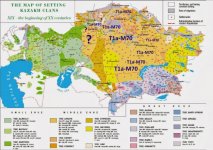To me, nailing the origin of T in the Mediterranean is actually pretty simple; we just need to take a look at southern Iberia. First of all, there's a very coastal Mediterranean bias for T in Europe; particularly west-Central Europe (Iberia+Italy and islands especially). Other than minor 5-10% highs in coastal cantabria or Asturias (probable Phoenician origin as well) there are the Tras O Montes Portuguese Jews that show about 15% T in their communities. These are small and isolated however. The question is, why is there 7% T in Andalusia? Why does Cadiz in particular have 10% T? Why does Ibiza have 17% T? Who visited these regions? The Phoenicians. We know Ibiza derives it's name from Phoenician Ybossim. There are also small Jewish communities on the Ibiza islands, notably on Majorca. But these Jews came up positive for 2% T. In a genetic study done on the high frequencies of T in Iberia, this Jewish community was effectively ruled out as the source of T on the Ibiza islands, thus another source was responsible for it; by far the most likely candidate are the Phoenicians.
Deep Ancestry Project book, written by Spencer Wells himself in 2007, haplogroup K2 description:
"Not all K-M9 descendants challenged the problem of the Pamir Knot. Others stayed in the relatively fertile environment of the near east. There, some 30,000 years ago, the marker M70 appeared and today defines this haplogroup, K2. Ancient members of haplogroup K2 dispersed across the Mediterranean world. They traveled west along the coast of north-Africa and also along the Mediterranean coastlines of Southern Europe. These movements suggest an intriguing possibility that the M70 marker may have been carried by Mediterranean traders such as the Phoenicians. These sea-faring people established a formidable, first millennium B.C. trading empire that spread westward, across the Mediterranean from its origins on the coast of modern-day Lebanon. M70 is found today throughout the Mediterranean, but it shows it's highest frequency (about 15 percent) in the Middle East and in north-east Africa. Members of this haplogroup are also found in southern Spain and France."
the only inconsistency would be the rarity of T in modern Lebanon (4.5-5%), but if that 16-21% of Jordanians IS in fact correct, that would mean this theory would be on the right track.
Deep Ancestry Project book, written by Spencer Wells himself in 2007, haplogroup K2 description:
"Not all K-M9 descendants challenged the problem of the Pamir Knot. Others stayed in the relatively fertile environment of the near east. There, some 30,000 years ago, the marker M70 appeared and today defines this haplogroup, K2. Ancient members of haplogroup K2 dispersed across the Mediterranean world. They traveled west along the coast of north-Africa and also along the Mediterranean coastlines of Southern Europe. These movements suggest an intriguing possibility that the M70 marker may have been carried by Mediterranean traders such as the Phoenicians. These sea-faring people established a formidable, first millennium B.C. trading empire that spread westward, across the Mediterranean from its origins on the coast of modern-day Lebanon. M70 is found today throughout the Mediterranean, but it shows it's highest frequency (about 15 percent) in the Middle East and in north-east Africa. Members of this haplogroup are also found in southern Spain and France."
the only inconsistency would be the rarity of T in modern Lebanon (4.5-5%), but if that 16-21% of Jordanians IS in fact correct, that would mean this theory would be on the right track.






